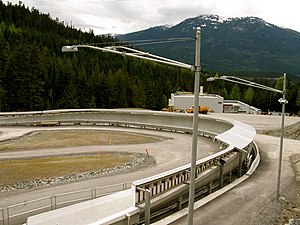The Whistler Sliding Centre

The Whistler Sliding Centre shown in June 2008. The refrigeration plant is shown behind turn 16.
|
|
| Location | Whistler, British Columbia, Canada |
|---|---|
| Coordinates | 50°6′27″N 122°56′42″W / 50.10750°N 122.94500°W |
| Owner | VANOC (2005 to 2010), Whistler 2010 Sports Legacies (since the end of the 2010 Winter Olympics) |
| Operator | VANOC (2005 to 2010), Whistler 2010 Sports Legacies (since the end of the 2010 Winter Olympics) |
| Capacity | 12,000 |
| Field size | (All from Bobsleigh/ Skeleton: 1,450 m (4,760 ft) Luge – men's singles: 1,374 m (4,508 ft) Luge – women's singles/ men's doubles: 1,198 m (3,930 ft) Junior: 953 m (3,127 ft) |
| Surface | Reinforced concrete with ammonia refrigeration piping that is turned on to create 2 to 5 cm (0.79 to 1.97 in) of ice. |
| Scoreboard | Yes |
| Construction | |
| Broke ground | 1 June 2005 |
| Built | 1 June 2005 to November 2007 |
| Opened | 19 December 2007 |
| Construction cost | C$105 million |
| Architect | Stantec Architecture Limited |
| Project manager | Heatherbrae |
| Services engineer | Western Pacific Enterprises GP/ Cimco Refrigeration (Toromont Industries Limited) |
| General contractor | Emil Anderson Construction Inc. |
| Main contractors | Emil Anderson Construction Inc. |
The Whistler Sliding Centre (French: Centre des sports de glisse de Whistler) is a Canadian bobsleigh, luge, and skeleton track located in Whistler, British Columbia, that is 125 km (78 mi) north of Vancouver. The centre is part of the Whistler Blackcomb resort, which comprises two ski mountains separated by Fitzsimmons Creek. Located on the lowermost slope of the northern mountain (Blackcomb Mountain), Whistler Sliding Centre hosted the bobsleigh, luge, and skeleton competitions for the 2010 Winter Olympics.
Design work started in late 2004 with construction taking place from June 2005 to December 2007. Bobsledders Pierre Lueders and Justin Kripps of Canada took the first run on the track on 19 December 2007. Certification took place in March 2008 with over 200 runs from six different start houses (the place where the sleds start their runs), and was approved both by the International Bobsleigh and Tobogganing Federation (FIBT) and the International Luge Federation (FIL). Training runs took place in late 2008 in preparation for the World Cup events in all three sports in early 2009. World Cup competitions were held in February 2009 for bobsleigh, luge, and skeleton. The top speed for all World Cup events set by German luger Felix Loch at 153.98 km/h (95.68 mph). In late 2009, more training took place in preparation for the Winter Olympics.
On 12 February 2010, the day of the Olympic opening ceremonies, Georgian luger Nodar Kumaritashvili was killed during a training run while reportedly going 143.3 km/h (89.0 mph). This resulted in the men's singles event being moved to the women's singles and men's doubles start house while both the women's singles and men's doubles event were moved to the junior start house. During actual luge competition at the 2010 Winter Olympics, there were only two crashes, which resulted in one withdrawal. Skeleton races on 18–19 February had no crashes though two skeleton racers were disqualified for technical reasons. Bobsleigh competitions had crashes during all three events. This resulted in supplemental training for both the two-woman and the four-man event following crashes during the two-man event. Modifications were made to the track after the two-man event to lessen the frequency of crashes as well. A 20-page report was released by the FIL to the International Olympic Committee (IOC) on 12 April 2010 and to the public on FIL's website on 19 April 2010 regarding Kumaritashvili's death. Safety concerns at Whistler affected the track design for the Sliding Center Sanki that was used for the 2014 Winter Olympics in Sochi. This included track simulation and mapping to reduce top speeds by 6 to 9 km/h (3.7 to 5.6 mph) for the Sochi track.
...
Wikipedia
